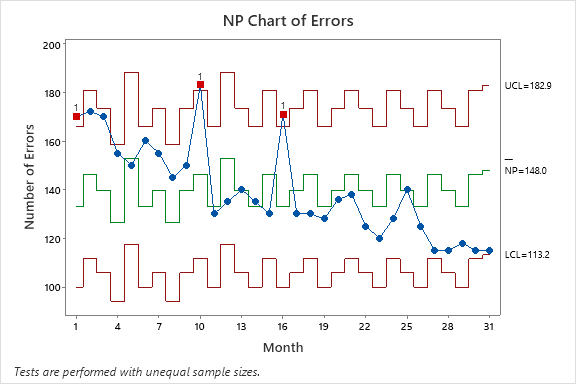
In the dynamic world of financial services, precision and efficiency are critically important, and statistical tools can help. Among these tools are control charts which can assist leaders at financial services firms who are seeking to monitor performance and navigate the intricate terrain of process enhancement.
We will explore two use cases in this blog post that show how control charts can enhance team performance and de-risk certain lengthy processes.
USe Case #1: Monitor Team Performance
There are several statistical tools located in Minitab that can help monitor your team’s performance and streamline your compliance operations.
Control charts can be used to monitor financial metrics or performance indicators to ensure they comply with the latest regulatory requirements. For example, control charts can track key financial ratios, such as capital adequacy ratios or liquidity ratios to ensure they remain within the control limits. Additionally, they can provide key insight into error rates for the purpose of compliance. This NP Chart provides more context:

The NP Chart of errors in this financial institution revealed crucial insights into the organization’s performance over a 31-month period. Since sending wires, answering emails and moving capital all generally require the human touch, it is reasonable to assume some errors will inevitably be made. But for the purpose of compliance, we want those errors to be as minimal as possible.
While the overall number of errors per sample size (sample size depended on the number of transactions performed in each time period, or “events,” such as emails, money movement or wires) demonstrated a promising downward trend, it is important to address the specific fail points at 1, 10 and 16.
These fail points indicate deviations from expected patterns and warrant further investigation. In this case, more errors were made than should have been made based on the sample size. To ensure compliance and sustain the improvement in error rates, it is essential to conduct a thorough analysis of these points. This analysis may involve examining the underlying causes, identifying potential process variations or external factors that contributed to the failures and implementing appropriate corrective actions. Perhaps the team was short-staffed, implementing a new process or was overly fatigued. Knowledge of these underlying factors can help with future corrective actions, such as adding additional staff or improved training.
By addressing the root causes of the test failures and proactively taking necessary measures, the financial institution can refine its compliance efforts, minimize errors and maintain a consistent trend of improvement over time.
use case #2: loan approval risk management and process improvement
Mitigating risk is critically important in the financial sector. A prime example of this involves loan approval turnaround time, where control charts offer a potent solution for risk reduction and process streamlining. Slow turnaround time can threaten business opportunities and can lead to customer dissatisfaction.
Imagine the leader of a financial services firm focusing on optimizing their loan approval process. Their objective is twofold: to ensure timely application processing and, more critically, to adhere to regulatory requirements. To achieve this, they leverage control charts for monitoring the turnaround time.
Upon compiling initial data and configuring the control charts, the team maintains the chart with new data (this can be done automatically with Minitab Connect). During analysis, the team detects a recurring trend of approval times consistently surpassing the upper control limit.
As mentioned previously, this flags a risk: persistent delays in specific loan categories’ approvals might trigger customer dissatisfaction, foregone business prospects and potential breaches of regulatory timeframes.
Through a comprehensive analysis, the manager pinpoints that specific loan application documents necessitate additional verification steps, causing notable delays. Moreover, an uneven distribution of workload among processors becomes known.
Empowered by this insight, they may opt to implement process enhancements. These include streamlining document verification, redistributing workload and offering extra training to loan processors.
As you make process changes, your control limits will change. Subsequent to these changes, the team continually tracks the control chart’s changes in a new stage with updated control limits. As the adjustments take effect, the team observes a gradual return of loan approval times within the control limits. This stands as evidence of effective risk management and improved operational efficiency.
conclusion
Through the lens of two impactful examples, we’ve witnessed how control charts bolster team performance and mitigate risk. By harnessing data-driven insights, financial institutions can navigate the complexities of compliance, minimize errors and drive continual enhancements, assisting their journey toward optimal efficiency and resilience.
Want to see for yourself? Check out how a leading financial services firm used control charts or download a free trial of Minitab Statistical Software today.

Be the first to comment